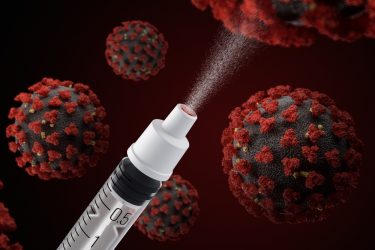Managing the next pandemic: the role of nasal vaccine administration
Posted: 30 August 2022 | Joe Neale (Recipharm) | No comments yet
In this article, Recipharm’s Joe Neale explores how learnings from the COVID-19 pandemic can be applied in the future and asks how nasal administration could help our fight against tomorrow’s outbreaks.


The COVID-19 pandemic has reminded the pharmaceutical industry of several key lessons. It has highlighted the value of cutting-edge technologies, such as messenger RNA (mRNA) vaccines, and reinforced the industry’s understanding of the power of collaboration, including with contract partners such as contract development and manufacturing organisations (CDMOs).
The successful roll-out of the global vaccination programme over the last 18 months was about more than just the ability of the industry to ramp up production to deliver billions of doses worldwide. It was about solving cold-chain logistical challenges and ensuring the vaccine doses themselves could be administered easily and efficiently with minimal discomfort for patients. We have been given a crash course in how to deliver vaccine doses successfully to billions of people.
So much progress has been made in the fight against COVID-19, now it is important for the pharmaceutical industry to begin considering how to apply our learnings to serve our future needs. We need to ask:
- how do we ensure we repeat our success in developing a viable vaccine for any future outbreak?
- how do we make certain we can deliver the required number of doses?
- and perhaps most importantly, how do we improve on our performance and make the vaccine even easier to administer – perhaps without the need for the patient to be in-clinic?
One possible answer to this last question, particularly for future influenza and coronavirus pandemics, could be the use of nasal vaccine administration.
The rise of the nasal vaccine route
Recent studies indicate that mucosal delivery of vaccines provides a better, longer-lasting effect than the traditional injection route.1 This novel approach has been found to trigger robust protective immune responses at the predominant sites of pathogen infection. In principle, the induction of adaptive immunity at mucosal sites, involving secretory antibody responses and tissue-resident T cells, has the capacity to prevent an infection – particularly for viruses such as influenza and coronavirus – from becoming established in the first place, rather than only curtailing infection and protecting against the development of disease symptoms.


In addition, there may be regulatory benefits to developing a nasal vaccine over an injectable one. Nasal delivery is non-invasive and provides a more targeted delivery than the systemic injectable approach, potentially offering a quicker response and reduced side effects.
With all of this in mind, it is no surprise that the nasal segment of the vaccine market is expected to reach $250.91 million by 2029, up from $122.287 million in 2021.2
However, harnessing this novel route of administration does pose challenges, which can hinder the development of nasal vaccines and potentially sector growth. Firstly, many biologic formulations, such as mRNA and other vaccines, can be fragile and prone to harm from administration devices. Recent research from the University of Amsterdam, for instance, shows that lipid nanoparticles of the kind used in mRNA vaccines can be damaged by nebulisers for oral inhalation.3
Moreover, for most biologic formulations, preservatives traditionally employed in nasal sprays (such as benzalkonium chloride) are incompatible and cannot be used, making the development of effective biologic formulations more challenging.
In addition, for vaccines and other biologic treatments, dose volume and the area of nasal cavity you need to dose is critical for effectiveness – this can pose issues when selecting an appropriate device to deliver a nasal vaccine. For example, standard nasal sprays feature swirl nozzles that typically have a spray cone angle of between 60 to 90 degrees, which can lead to most of the formulation hitting the walls of the nose, rather than penetrating further into the nasal cavity, impacting on dose uniformity.
Key to overcoming many of these challenges lies in the evolution of nasal spray device design.
The current state of the nasal spray device landscape
There is a large and varied array of nasal spray devices currently available on the market, all used for a wide variety of drug products. Each one has its own features and benefits that make them more suitable for certain applications than others. Some of the most common include:
- Multi-dose nasal pump sprays: these are the most popular devices on the market, featuring a large reservoir that can contain sufficient formulation to last for up to three months. Most formulations are preserved; however, some are preservative free and aseptically filled into the container of their microbial safe pump systems.
- Prefilled unit dose nasal sprays: these are designed to administer a single dose and are disposable. They are often used for treatments such as opioid overdose, pain relief, seizures, anxiety and allergic rhinitis. The unit dose market is expected to grow significantly in the next five to 10 years, both in terms of volume and value.
- Luer lock spray devices: These are empty and reusable medical devices featuring a luer lock, which can be screwed on a disposable syringe, minimising the amount of material thrown away.
- Bi-dose nasal sprays: A device that contains two discrete sprays, one for each nostril. There are different types, such as prefilled sprays and luer lock sprays.
- Soft mist inhalers (SMIs): a liquid inhaler capable of producing a slow-moving aerosol cloud. These devices provide convenient, optimal drug delivery to the lungs or nasal cavity while reducing the need for patient coordination and inspiratory effort.
As explored earlier, many of these standard nasal spray devices were not developed with the needs of biologic and vaccine formulations in mind. Further, they often require considerable design customisation to ensure they are effective at delivering the required dose, which can add considerable time and cost to any nasal vaccine project. These challenges the potential to hold back the creation and commercialisation of viable nasal vaccines.
Overcoming nasal spray design challenges
A number of innovations to nasal spray design that have been developed in recent years have the potential to address the issues presented by traditional devices when it comes to the delivery of biologics. Some of the key developments include:
- New more targeted nozzle designs suitable for sensitive formulations. A narrower spray cone is beneficial in addressing the dosing problems posed by traditional wide-cone nozzles, allowing more of the dose to reach the nasal cavity to improve dose uniformity. A new generation of spray nozzles, such as the Rayleigh spray nozzle from Medspray, have been developed to allow the fine-tuning of the spray cone angle, from 0 to 30 degrees. This results in a higher dose, especially in the upper turbinates and the olfactory regions of the nasal cavity. Recent studies show that, when incorporated into a SMI nasal spray, such a nozzle can evenly distribute a soft mist into the nasal cavity, ensuring effective even dosing,1 with clear potential for optimising the performance of a biologic formulation, such as a nasal vaccine. SMIs also offer benefits for the delivery of sensitive biologics, such as nasal vaccines, minimising the risk of damage to the formulation that can impede effectiveness.
- Device platforms to streamline development. A number of new nasal spray device innovations in recent years have the potential to simplify the device development process, streamline the regulatory process, and make nasal delivery more financially viable for vaccines. The development of new device platforms, for instance, can reduce the need for customisation to the specific needs of the formulation, reducing the burden of regulatory approval for each new product. For example, there are SMIs in development that combine a multi-use device with a disposable syringe containing the formulation. This reduces the need to design a complex new device as well as the need for high-volume device manufacturing.
- In addition, a new generation of unit dose nasal sprays featuring a user independent delivery mechanism and modular nozzle design has been designed specifically to meet the needs of the emergency and non-emergency use market and shows considerable potential for overcoming the device development issues for nasal vaccines.
These innovations can go a long way towards making nasal a viable route for vaccine development. They can reduce development timeframes, optimise manufacturing efficiency and help to create a more convenient end-product for both patients and healthcare providers.
Nasal vaccine innovation the answer to future pandemic challenges


While we do not know when and where the next pandemic will strike, nor the pathogen that will cause it, we can be confident that there will be another in the future. The sooner we learn lessons from the last outbreak and take action to plan for the future, the better prepared we will be. This action must include changes to the way we develop, manufacture and administer vaccines so we can roll out mass vaccination programmes more quickly.
Nasal administration offers an alternative approach to streamline this process, especially when combined with advancements in device design, which have improved not just dosing precision, but the cost-efficiency of the devices themselves. Such innovations are set to drive growth in the nasal vaccine segment and have the potential to help us deliver an even faster response in the event of a future pandemic.
About the author
Joe Neale is Head of Innovation, Product Development and Programme Management for the Advanced Delivery System business unit of Recipharm. He is a biochemist by training, with a masters in translational medicine. Joe has over 25 years of experience developing product within the diagnostic, medical device and combination product field.
References
- Lavelle E, Ward R. Mucosal vaccines — fortifying the frontiers. Nature Reviews Immunology. 2021;22(4):236-250.
- https://www.databridgemarketresearch.com/reports/global-nasal-spray-vaccine-market
- Klein D, Poortinga A, Verhoeven F, et al. Degradation of lipid based drug delivery formulations during nebulization. Chemical Physics. 2021;547:111192.
Interested in nasal vaccine delivery? Check out our related content:
Is albumin the key to successful nasal vaccines?
Is intranasal drug delivery the best way to administer COVID-19 therapeutics?
EPR Podcast Episode 3 – Inhaled and intranasal drug formulations and delivery
Related topics
Biologics, Drug Delivery Systems, Drug Development, Industry Insight, Research & Development (R&D), Respiratory Drug Delivery (RDD), Vaccine Technology, Vaccines, Viruses









